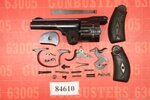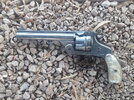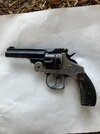If you haven't noticed from my other posts, I do suffer from Obsessive, Compulsive Disorder. I was so smitten with the 38 DA that I bought a Junker 32 DA and got it back to working. It only follows that I'd buy a 44 DA. Consistent with the 38 and the 32, it needs work and is 'finish challanged'. But I'm too cheap to buy one that is a collector piece.
Just a little background. All three Double Action models are based on the same design and basically use the same parts just sized for the revolver. There were 5 design changes in both the 32 and 38 DA but the 44 never went through a design change. As such all 44 DAs have the double cyclinder stops and notches that the first and second model 32 and 38 had. The 32 was built on the #1 frame, 38 on the #2 frame, and 44 on the #3 frame that the earlier single actions revolvers were built on. I don't know if the frames were 'exactly' the same, but they are at least approximately the same size.
This one was purchased with full knowledge that it didn't hold on the single cock or half cock notch. Figuring this meant a new hammer my offer was substantially lower than the asking price. The list price was $1,400 that he quickly came down to $1,100. Assuming the hammer needed to replaced I walked away the first day to do some research. Research got me to a wild guess on what a replacement hammer would cost. My guess was $200. considering the finish and the hammer issues I offered $800 and he countered with $900. I probably should have walked away from the $900 but I didn't.
It does cycle OK in double action. Won't hold worth a darn in single action and for some reason didn't register that there was even a half cock notch. But all of that is limited to the hammer and possibly the rear sear and rear sear spring. Here are some basic pictures.


So to get to the nitty gritty and keep this post relevant to the Gunsmithing forum, here are the issues I have to deal with.
As I said, the revolver will not hold at single cock. It pushes off. Looking at the hammer, the single cock notch looks sharp though I haven't taken it out to do a complete investigation. I cannot tell if the rear sear is in good shape or not without taking it out. I did purchase a new rear sear just in case. I probably should have bought a new rear sear spring as that provide the force to keep the rear sear in contact with the single cock notch. But that isn't the end of the issues with the hammer. It appears that someone has ground off the half cock notch entirely. Now that I didn't expect. Here is a picture of the hammer. In this picture you can see the rear sear pushing up against the bottom of the hammer where the half cock notch should be.

Although the NRA did an article on the 44 DA and said there wasn't any type of safety, all of the pictures I've seen of 44 DA hammers have the half cock notch. For clarification, here is a picture of the 38 DA hammer showing the missing half cock notch with the rear sear engaged in the half cock notch.

As you can see, quite a bit of metal has been taken off (why would somebody do this?) And it does cause some issues even with the double action trigger pull. The rear sear is constantly being pushed up by the rear sear spring and rides the contour of the bottom of the hammer. Although the double action always functions, the irregularity of the contour on the bottom of the hammer sometimes hangs up the rear sear and it feels 'different'.
The real answer is to find another hammer. And if I were to find one, the push off issue might be resolved. But so far none of the suppliers has one or even lists one. We may be taking a trip down to @Jackrabbit1957 to see what he thinks.
Any thoughts on how to salvage this hammer?
I've used this animation in a couple of posts. But it shows the inter-relationship of the hammer, rear sear, rear sear spring. The diagram below comes from the animation of a 38 DA that really helped me understand how to put these things together. The animation can be found here.
Below, the blue is the rear sear spring, the red is the rear sear, and the green is the cylinder stop. I believe the diagram below is with the hammer at single cock.

Just a little background. All three Double Action models are based on the same design and basically use the same parts just sized for the revolver. There were 5 design changes in both the 32 and 38 DA but the 44 never went through a design change. As such all 44 DAs have the double cyclinder stops and notches that the first and second model 32 and 38 had. The 32 was built on the #1 frame, 38 on the #2 frame, and 44 on the #3 frame that the earlier single actions revolvers were built on. I don't know if the frames were 'exactly' the same, but they are at least approximately the same size.
This one was purchased with full knowledge that it didn't hold on the single cock or half cock notch. Figuring this meant a new hammer my offer was substantially lower than the asking price. The list price was $1,400 that he quickly came down to $1,100. Assuming the hammer needed to replaced I walked away the first day to do some research. Research got me to a wild guess on what a replacement hammer would cost. My guess was $200. considering the finish and the hammer issues I offered $800 and he countered with $900. I probably should have walked away from the $900 but I didn't.
It does cycle OK in double action. Won't hold worth a darn in single action and for some reason didn't register that there was even a half cock notch. But all of that is limited to the hammer and possibly the rear sear and rear sear spring. Here are some basic pictures.


So to get to the nitty gritty and keep this post relevant to the Gunsmithing forum, here are the issues I have to deal with.
As I said, the revolver will not hold at single cock. It pushes off. Looking at the hammer, the single cock notch looks sharp though I haven't taken it out to do a complete investigation. I cannot tell if the rear sear is in good shape or not without taking it out. I did purchase a new rear sear just in case. I probably should have bought a new rear sear spring as that provide the force to keep the rear sear in contact with the single cock notch. But that isn't the end of the issues with the hammer. It appears that someone has ground off the half cock notch entirely. Now that I didn't expect. Here is a picture of the hammer. In this picture you can see the rear sear pushing up against the bottom of the hammer where the half cock notch should be.

Although the NRA did an article on the 44 DA and said there wasn't any type of safety, all of the pictures I've seen of 44 DA hammers have the half cock notch. For clarification, here is a picture of the 38 DA hammer showing the missing half cock notch with the rear sear engaged in the half cock notch.

As you can see, quite a bit of metal has been taken off (why would somebody do this?) And it does cause some issues even with the double action trigger pull. The rear sear is constantly being pushed up by the rear sear spring and rides the contour of the bottom of the hammer. Although the double action always functions, the irregularity of the contour on the bottom of the hammer sometimes hangs up the rear sear and it feels 'different'.
The real answer is to find another hammer. And if I were to find one, the push off issue might be resolved. But so far none of the suppliers has one or even lists one. We may be taking a trip down to @Jackrabbit1957 to see what he thinks.
Any thoughts on how to salvage this hammer?
I've used this animation in a couple of posts. But it shows the inter-relationship of the hammer, rear sear, rear sear spring. The diagram below comes from the animation of a 38 DA that really helped me understand how to put these things together. The animation can be found here.
Below, the blue is the rear sear spring, the red is the rear sear, and the green is the cylinder stop. I believe the diagram below is with the hammer at single cock.



















